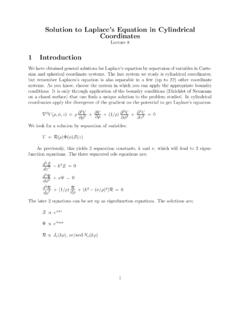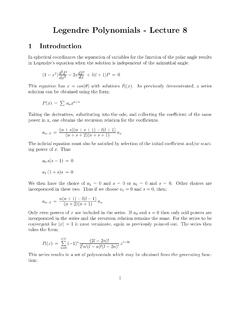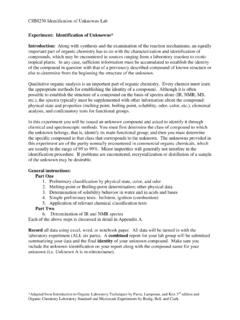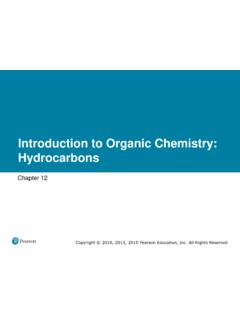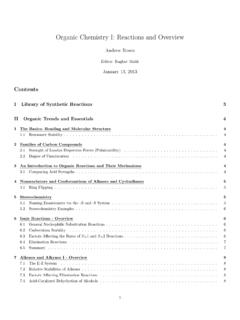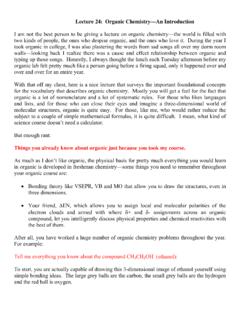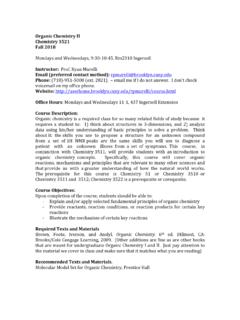Transcription of Introduction to the Chemistry of Life - University of Houston
1 1 Introduction to the Chemistry of Life This chapter introduces you to life at the biochemical and cellular level. It begins with a discussion of the chemical origins of life and its early evolution. This discussion continues into ideas and theories about the evolution of organisms, followed by a brief Introduction to taxonomy and phylogeny viewed from a molecular perspective. The chapter concludes with an Introduction to the basic concepts of thermodynamics and its application to living systems. Biochemistry, like all other sciences, is a based on the measurement of observable phenomena. Hence, it is important to become familiar with the conventions used to measure energy and mass. Box 1-1 presents the essential biochemical conventions that we will encounter throughout Fundamentals of Biochemistry. Essential Concepts The Origin of Life 1. Living matter consists of a relatively small number of elements, of which C, N, O, H, Ca, P, K, and S account for ~98% of the dry weight of most organisms (which are 70% water).
2 These elements form a variety of reactive functional groups that participate in biological structure and biochemical reactions. 2. The current model for the origin of life proposes that organisms arose from the polymerization of simple organic molecules to form more complex molecules, some of which were capable of self-replication. 3. Most polymerization reactions involving the building of small organic molecules into larger more complex ones occur by the formation of water. This is called a condensation reaction. Cellular Architecture 4. A key development in the origin of life was the formation of a membrane that could separate the critical molecules required for replication and energy capture from a potentially degradative environment. 5. Complementary surfaces of molecules and macromolecules provide a template for biological specificity ( , macromolecular assembly, enzyme activity, and expression and replication of the genome).
3 Chapter 1 Introduction to the Chemistry of Life 26. Modern cells can be classified as either prokaryotic or eukaryotic. Eukaryotic cells are distinguished by a variety of membrane-bounded organelles and an extensive cytoskeleton. Organismal Evolution 7. Prokaryotes show a limited range of morphologies but very diverse metabolic capabilities. 8. Phylogenetic evidence based on comparisons of ribosomal RNA genes have been used by Woese and colleagues to group all organisms into three domains: archaea, bacteria, and eukarya. 9. The evolution of sexual reproduction marks an important step of the evolution of organisms, because it allows for genetic exchanges that lead to an increase in the adaptability of a population of organisms to changing environments. 10. Eukaryotes contain several membrane-bounded structures, such as mitochondria and chloroplasts, that may be descended from ancient symbionts.
4 11. Archaea represent a third domain or branch of life in the three-domain system of classification. While they outwardly resemble bacteria, their genomes and the proteins encoded in them more closely resemble those of eukaryotes. 12. Biological evolution is not goal-directed, requires some built-in sloppiness, is constrained by its past, and is ongoing. 13. Natural selection directs the evolution of species. Thermodynamics 14. The first law of thermodynamics states that energy (U) is conserved; it can neither be created nor destroyed. 15. Enthalpy is a thermodynamic function that is a sum of the energy of the system and the product of the pressure and the volume (PV). Since biochemical processes occur at constant pressure and have negligible changes in volume, the change of energy of the system is nearly equivalent to the change in enthalpy ( U = H).
5 16. The second law of thermodynamics states that spontaneous processes are characterized by an increase in the entropy of the universe, that is, by the conversion of order to disorder. 17. The spontaneity of a process is determined by its free energy change ( G = H T S). Spontaneous reactions have G < 0 (exergonic) and nonspontaneous reactions have G > 0 (endergonic). 15. For any process at equilibrium, the rate of the forward reaction is equal to the rate of the reverse reaction, and G = 0. Chapter 1 Introduction to the Chemistry of Life 318. Energy, enthalpy, entropy, and free energy are state functions; that is, they depend only on the state of the system, not its history. Hence, they can be measured by considering only the initial and final states of the system and ignoring the path by which the system reached its final state. 19. The entropy of a solute varies with concentration; therefore, so does its free energy.
6 The free energy change of a chemical reaction depends on the concentration of both its reactants and its products. 20. For the general reaction aA + bB U cC + dD the free energy change is given by the following relationship: [][ ][][]CcDdGGRTlnAaBb = + 21. The equilibrium constant of a chemical reaction is related to the standard free energy of the reaction when the reaction is at equilibrium ( G = 0), so that we have G = RT ln Keq where Keq is the equilibrium constant of the reaction: Keq = [C]ceq [D]deq[A]aeq [B]beq The equilibrium constant can therefore be calculated from standard free energy data and vice versa. 22. The equilibrium constant varies with temperature by the relation 1 HSlnKeqRTR =+ where H and S represent enthalpy and entropy in the standard state. A plot of Keq versus 1/T, known as a van t Hoff plot, permits the values of H and S (and therefore G at any temperature) to be determined from measurements of Keq at two (or more) temperatures.
7 23. The biochemical standard state is defined as follows: The temperature is 25 C, the pH is , and the pressure is 1 atm. The activities of reactants and products are taken to be the total activities of all their ionic species, except for water, which is assigned an activity of 1. [H+] is also assigned an activity of 1 at the physiologically relevant pH of 7. These Chapter 1 Introduction to the Chemistry of Life 4conditions are different than the chemical standard state, so that the biochemical standard free energy is designated as G and in the chemical standard state is G . We assume that activity equals molarity for dilute solutions. 24. An isolated system cannot exchange matter or energy with its surroundings. A closed system can exchange only energy with its surroundings. A closed system inevitably reaches equilibrium. Open systems exchange both matter and energy with their surroundings and therefore cannot be at equilibrium.
8 Living organisms must exchange both matter and energy with their surroundings and are thus open systems. Living organisms tend to maintain a constant flow of matter and energy, referred to as the steady state. 25. Living systems can respond to slight perturbations from the steady state to restore the system back to the steady state. This process underlies the physiological concept of homeostasis. 26. The recovery of free energy from a biochemical process is never total, and some energy is lost to the surroundings as heat. Hence, while the system becomes more ordered, the surroundings experience an increase in entropy. 27. Enzymes accelerate the rate at which a biochemical process reaches equilibrium. They accomplish this by interacting with reactants and products to provide a more energetically favorable pathway for the biochemical process to take place. Key Equations Be sure to know the conditions for which the following thermodynamics equations apply and be able to interpret their meaning.
9 1. U = q w 2. H = U + PV 3. H = qP w + P V 4. S = kB ln W 5. S qT = HT 6. G = H T S 7. [][ ][][]CcDdGGRTlnAaBb = + 8. G = RT ln Keq Chapter 1 Introduction to the Chemistry of Life 59. Keq = [C]ceq [D]deq[A]aeq [B]beq 10. 1 HSlnKeqRTR =+ Guide to Study Exercises (Text p. 20) 1. The major stages of chemical and organismal evolution are: Formation of simple organic compounds. Polymerization of small molecules to form more complex molecules. Replication, the self-directed synthesis of additional molecules. Concentration of molecules and compartmentation of chemical reactions. Development of systems for synthesizing precursors and generating energy. Organization of simple cells. Emergence of sexual reproduction. Cooperation among cells in multicellular organisms. (Sections 1-1 to 1-3) 2. Evolution occurs when the makeup of a population is altered as specific variants are passed from individuals to their offspring.
10 The variants that come to predominate are those that increase the ability of individuals to survive and reproduce under the prevailing conditions; that is, those that are selected by nature. These principles of evolution by natural selection apply to living organisms or any self-replicating system. (Sections 1-1B and 1-3C) 3. The archaea include methanogens, halobacteria, and some thermophiles. The bacteria include organisms such as E. coli and cyanobacteria. The eukarya include protozoans, fungi, plants, and animals. (Section 1-3A) 4. The first law of thermodynamics states that energy is conserved and can be neither created nor destroyed. It may, however, be transferred, for example, in the form of heat or work, between a closed or open system and its surroundings. The second law of thermodynamics states that spontaneous processes are characterized by increasing disorder (increasing entropy).
